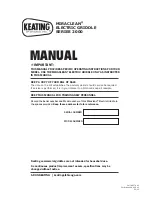
MP5017-2002
Accu-Steam Gas Griddle
18
3.10.2 FLAME SENSE RECTIFICATION
The Accu-Steam Gas Griddle utilizes a flame
sensing circuit to determine if the system has
proper combustion. When the system is turned
on, gas is sent to the burner and an electronic
ignition tries to ignite the burner. The ignition
module then checks to see if flame is
established in the burner.
If the flame sense feedback is within the proper
range the system will stay on until the control
board ceases the call for heat.
The ignition module continues to monitor the
voltage and as long as its within the proper
range the burner will stay on. If the flame sense
reading falls below the threshold of 0.38 DCμA
(microamperes) the griddle will go into lock
out and will stop heating. The external signal
for a lock-out is a 4 second flash on the FAULT
light.
1. The flame sense should be monitored and
recorded as part of the install.
2. To test for flame sense, Disconnect the
orange wire from the flame sense.
3. Connect the probes of an multimeter
capable of reading DCμA (DC micro-
amperes) to the flame sensor and orange
wire.
4. Run the unit and monitor the reading.
5. If the gas pressure is set correctly for the
gas type the reading should be 4 to 6
DCμA.
3.10.3 IGNITION TROUBLESHOOTING
Should the unit trigger an ignition lockout
during installation and testing, verify the
following
1. Verify the flame sense is above 0.38 DCμA.
a. If the reading is zero, ensure the flame
sense is not grounded.
b. If the reading fluctuates, check for drafts
that could be causing an unstable flame or
loose venturi connections to the burners
c. Ensure the flame sense is properly placed to
be engulfed by flame.
2. Double check the gas hose connection and
verify pressure.
a. Ensure the dynamic pressure is set to 5
Inches Water Column.
b. Test the unit when the supply is under
maximum load, ensure the static and
dynamic pressures do not fluctuate.
c. If an external regulator is connected to the
gas line, ensure its breathing vent is clear.
3. Confirm the ignition and ground probes are
correctly spaced.
a. The probes should have a gap of 0.125
±.020.





































